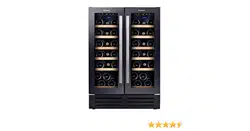Loading ...
Loading ...
Loading ...

.12.
corks from shrinking.
o After a bottle of wine has been opened, the wine comes into contact
with air. So it is best to store the remainder of the bottle upright, to
minimize the surface area of the wine that is coming into contact with
the air.
o Once opened, wine will remain in a drinkable condition for two days for
delicate whites or three days for rich reds, as long as the bottle as been
resealed. You should make sure that the seal is firm by checking the
stopper.
o Special stoppers that keep wine sparkling and Champagne bubbling for
one or two days after opening, can be bought at most good wine shops.
o When stored correctly, white wines can keep well for up to two years. Full
bodied reds will age well for ten years and dessert wines will age well for
up to twenty years.
o When you buy a bottle of wine, you should transfer it to a suitable storage
location immediately (if you are not going to store it in your Wine Cooler).
o Cheaper bottles of wine will not age as well as more expensive ones.
o To make the most of the bouquet and taste of your wine, never ll more
than half a glass at a time. It will also help if the shape of your wine glass
is appropriate for your wine. The size and shape of your wine glass’s bowl
will determine the intensity and complexity of the bouquet. The stem
should be long enough to allow you to avoid hand contact with the
bowl of the glass and should be tulip-shaped or tapered at the top.
Wine Storage Problems
Corking- a tiny percentage of bottled wine (about 1%) will suffer from this.
The cork reacts with the wine and gives it a musty, unpleasant taste. It is the
most common wine storage problem and is caused by harmless bacteria
growing on the cork. As unfortunate as this is, there is nothing to do but to
discard all of the wine in the affected bottle. This is not to be confused with
small fragments of cork oating in the wine itself, which will not impair the
avour.
Oxidisation- when wine has been opened and left for longer than a day;
it tends to lose its aroma and colour, giving an overall at taste. The only
way to avoid this, it to either drink the wine on the same day it was opened
or to use a vacuum device specially designed for removing oxygen from
opened wine bottles. If you use such a device, the wine should still be
consumed shortly afterwards.
Ullage- this is loss of wine from the bottle by evaporation or leakage. Signs
of ullage include wine seeping around the cork, a protruding cork or a
stained label. It can happen if the bottle has been allowed to get too
warm. The wine may still be drinkable, if the leakage was recent; however,
Loading ...
Loading ...
Loading ...
